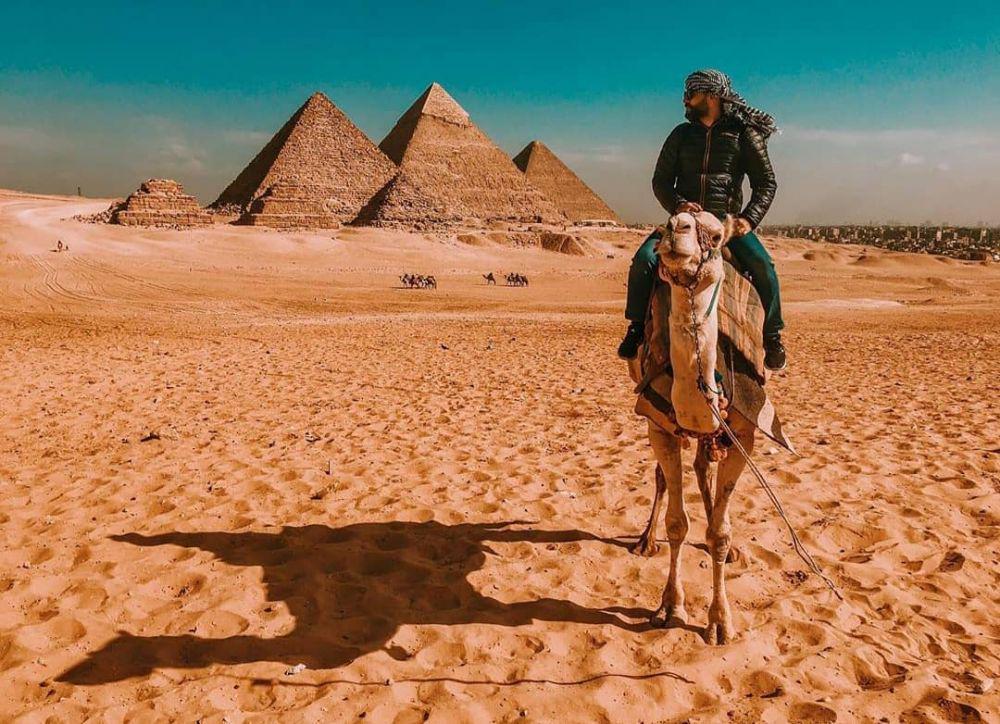
Exploring Egypt’s Rich History: A Guide to Its Most Iconic Landmarks
Egypt is one of the most fascinating countries in the world, not only because of its iconic pyramids or its desert landscapes but also because of its deep and complex history that spans thousands of years. From the ancient civilizations of the Pharaohs to the rise of Christianity and Islam, Egypt’s story is a tale of empire, conquest, and cultural evolution. This article will guide you through Egypt’s most iconic landmarks, each a key to understanding the country’s rich history. Whether you’re a history buff, an archaeology enthusiast, or someone simply curious about Egypt’s past, these landmarks should be on your travel bucket list.
1. The Pyramids of Giza: The Epitome of Ancient Egypt
When most people think of Egypt, they immediately picture the Pyramids of Giza, which are some of the most recognizable structures in the world. Located just outside Cairo, the pyramids are a testament to the advanced engineering and architectural abilities of the ancient Egyptians. The Great Pyramid of Giza, built for Pharaoh Khufu around 2580 BC, was originally 146 meters (480 feet) tall, and it was the tallest man-made structure in the world for over 3,800 years.
The pyramids were constructed as tombs for the pharaohs, designed to ensure their safe journey to the afterlife. Over 2 million limestone blocks, each weighing between 2 and 30 tons, were used to build the Great Pyramid. It’s an incredible feat of human ingenuity and perseverance. The surrounding pyramids, built for Khafre and Menkaure, along with the famous Great Sphinx of Giza, a colossal limestone statue with the body of a lion and the head of a pharaoh, further enhance the site’s grandeur.
Why Visit?
• Architectural Wonder: The sheer scale and precision of the pyramids continue to baffle modern engineers.
• Historical Significance: The pyramids are a symbol of ancient Egypt’s power and beliefs in the afterlife.
• Photography: There’s no shortage of breathtaking views of the pyramids, especially at sunrise and sunset, when the golden light casts long shadows.
2. The Egyptian Museum: The Heart of Egyptology
Located in Cairo, the Egyptian Museum is one of the world’s most important collections of ancient Egyptian artifacts. With over 120,000 objects, this museum is a paradise for history lovers. The museum houses everything from mummies, sarcophagi, and statues to jewelry, furniture, and even the famous Tutankhamun exhibit.
Tutankhamun, often referred to as King Tut, was a young pharaoh whose tomb was discovered in 1922 by British archaeologist Howard Carter. The treasures found in his tomb, including the world-renowned gold death mask, are housed in the museum. Other highlights include the Royal Mummy Room, where visitors can see the mummies of some of Egypt’s most famous pharaohs, including Ramses II and Seti I.
Why Visit?
• Treasure Trove of History: The museum provides an unparalleled glimpse into ancient Egyptian life, offering the chance to see artifacts that were buried with pharaohs thousands of years ago.
• King Tut’s Tomb: Seeing the treasures of King Tut, including his iconic golden mask, is a once-in-a-lifetime experience.
• Learning Opportunity: The museum’s exhibits are well-curated and provide a rich educational experience about ancient Egyptian culture, religion, and daily life.
3. Luxor: The World’s Greatest Open-Air Museum
Known as the “world’s greatest open-air museum”, Luxor is home to some of Egypt’s most impressive archaeological sites, including the Valley of the Kings, Karnak Temple, and the Luxor Temple. This city, which was once the capital of ancient Egypt, offers an incredible window into the country’s past.
One of the highlights of Luxor is the Karnak Temple Complex, a sprawling religious site dedicated to the god Amun-Ra. The most famous part of Karnak is the Great Hypostyle Hall, a room filled with 134 massive columns, some of which stand over 60 feet tall. The wall carvings and hieroglyphs here depict scenes of the pharaohs’ victories and religious rituals, offering a glimpse into the culture of ancient Egypt.
Another must-visit site in Luxor is the Valley of the Kings, a burial ground for many of Egypt’s most famous pharaohs, including Ramses II, Seti I, and Tutankhamun. The tombs here are decorated with intricate artwork depicting the journey to the afterlife. The tomb of King Tut is the most famous, due to its discovery in 1922 by Howard Carter, but other tombs, such as that of Ramses VI, are equally impressive.
Why Visit?
• Monumental Temples: The scale and beauty of Luxor’s temples, especially Karnak, are awe-inspiring.
• Ancient Tombs: The Valley of the Kings offers the chance to enter the tombs of Egypt’s pharaohs and experience firsthand the intricate wall paintings and carvings.
• Rich History: Luxor’s wealth of archaeological sites provides a detailed look at the religious and cultural practices of ancient Egyptians.
4. Abu Simbel: A Monument to Pharaoh Ramses II
Located in southern Egypt near the border with Sudan, the Abu Simbel Temples are a monumental tribute to the power of Pharaoh Ramses II. These temples were carved directly into the mountainside in the 13th century BC and are dedicated to the gods Ra-Horakhty, Amun, Ptah, and Ramses II himself. The larger of the two temples is adorned with four colossal statues of Ramses II, each standing at over 65 feet tall, representing his might and divine status.
The smaller temple was built for Ramses II’s wife Nefertari and is dedicated to the goddess Hathor. Both temples were originally situated along the Nile River, but in the 1960s, they were relocated due to the construction of the Aswan High Dam. The relocation of the temples is one of the greatest feats in modern archaeology, ensuring that these remarkable monuments are preserved for future generations.
Why Visit?
• Colossal Statues: The giant statues of Ramses II and Nefertari are among the most recognizable images of ancient Egypt.
• Stunning Views: The temples are set against the backdrop of the desert, creating a dramatic and breathtaking landscape.
• Historical Significance: Abu Simbel represents Ramses II’s legacy and his devotion to the gods and his queen.
5. The Temple of Philae: A Temple to Isis
The Temple of Philae is dedicated to the goddess Isis and is located on an island in Lake Nasser. Originally situated near the First Cataract of the Nile, the temple was relocated to its current position in the 1960s due to the construction of the Aswan High Dam. Today, the temple is one of the most beautiful and serene ancient sites in Egypt.
Philae was an important religious center for the worship of Isis, who was believed to be the goddess of magic and healing. The temple complex includes several buildings and pylons, as well as an open-air sanctuary. The well-preserved carvings and reliefs depict scenes of religious rituals, as well as stories of the gods.
Why Visit?
• Peaceful Atmosphere: Philae is quieter and less crowded than other Egyptian temples, offering a peaceful experience.
• Stunning Location: The temple’s island setting in Lake Nasser makes it one of the most picturesque sites in Egypt.
• Cultural Significance: As the center of the cult of Isis, Philae offers insight into the religious practices of ancient Egyptians.
6. Siwa Oasis: A Hidden Gem in the Western Desert
While many visitors flock to Egypt’s famous archaeological sites, the Siwa Oasis offers a more peaceful and remote experience. Situated in Egypt’s Western Desert, near the Libyan border, Siwa is one of the most isolated and culturally unique destinations in Egypt.
The oasis is home to a variety of ancient sites, including the Temple of Amun—the very temple where Alexander the Great was proclaimed the son of the god Amun. The temple, which is in ruins today, was once the site of the famous oracle that influenced many historical events.
Siwa is also known for its unique culture, which is distinct from the rest of Egypt. The Siwan people speak a language of Berber origin and have customs and traditions that have remained largely unchanged for centuries.
Why Visit?
• Natural Beauty: Siwa is surrounded by palm groves, salt lakes, and lush greenery, offering a tranquil escape from the desert.
• Historical Sites: The Temple of Amun and the ancient Shali Fort offer a glimpse into Egypt’s past.
• Unique Culture: The Berber-speaking Siwan people offer a fascinating cultural experience.
7. The Red Sea: Egypt’s Underwater Treasures
While Egypt is most famous for its ancient history, it also offers some of the best diving and snorkeling experiences in the world. The Red Sea is renowned for its crystal-clear waters, vibrant coral reefs, and diverse marine life. Popular destinations like Sharm El-Sheikh, Hurghada, and Marsa Alam attract thousands of visitors each year to explore their underwater treasures.
Underwater enthusiasts can discover vibrant coral gardens, swim alongside colorful fish, and even spot large marine life such as dolphins and turtles. For history lovers, the Red Sea also offers access to ancient shipwrecks, some dating back to the time of the Pharaohs.
Why Visit?
• Diving and Snorkeling: The Red Sea is home to some of the world’s best dive sites.
• Beautiful Beaches: The resorts along the Red Sea offer some of Egypt’s most relaxing and picturesque beach vacations.
• Marine Life: The vibrant marine life and coral reefs make the Red Sea an underwater paradise.
Conclusion
Egypt’s landmarks are a window into one of the world’s oldest and most influential civilizations. From the Pyramids of Giza to the remote Siwa Oasis, each site offers a unique glimpse into the country’s rich history, culture, and religion. Whether you’re marveling at the engineering feats of the ancient Egyptians, exploring the burial sites of pharaohs, or diving into the vibrant waters of the Red Sea, Egypt offers something for every traveler. So, pack your bags, and embark on a journey to discover the treasures of this timeless land.





